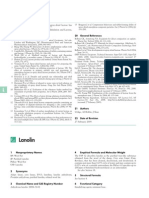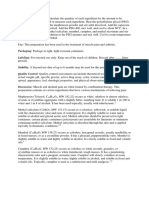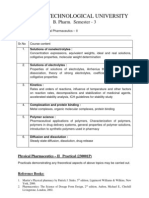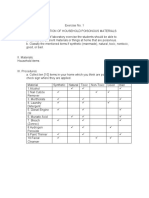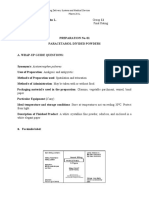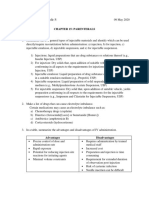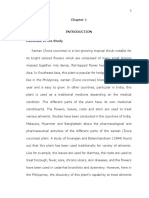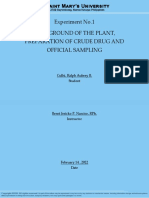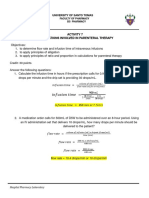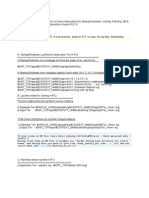Professional Documents
Culture Documents
Ethnobotany Assignment
Ethnobotany Assignment
Uploaded by
Melissa KittycatOriginal Description:
Copyright
Available Formats
Share this document
Did you find this document useful?
Is this content inappropriate?
Report this DocumentCopyright:
Available Formats
Ethnobotany Assignment
Ethnobotany Assignment
Uploaded by
Melissa KittycatCopyright:
Available Formats
Ethnobotany-an Introduction:
Ethnobotany (from "ethnology" - study of culture and "botany" - study of plants) is the scientific study of the relationships that exist between people and plants. Ethnobotanists aim to document, describe and explain complex relationships between cultures and (uses of) plants: focusing, primarily, on how plants are used, managed and perceived across human societies (e.g. as foods; as medicines; in divination; in cosmetics; in dyeing; as textiles; in construction; as tools; as currency; as clothing; in literature; in rituals; and in social life). Ethnobotany is defined as the study of the relationship between people and plants and most commonly refers to the study of indigenous uses of plants. In other words, it is the marriage between cultural anthropology and botany, a study that investigates the roles of plants as medicine, nourishment, natural resources or gateways to GOD. Usually it is considered a relatively young field of study. Officially it has only been recognized as an academic discipline for about a hundred years. However, this view is deceptive.
In fact, the investigation of plants and their uses is one of the most primary human concerns, which has been practiced by all cultures for tens, if not hundreds of thousands of years - its just that it wasn't called 'Ethnobotany' then. People have always depended on plants for their primary needs, (food, shelter, warmth, medicines, etc.etc.), and thus naturally have learned their uses. In the course of nomadic roaming this knowledge was exchanged with neighboring tribes, friends and foe and was gradually expanded upon. Thus, plant knowledge has been passed around the world since the beginning of time - and frequently the actual plants themselves have spread along with it.
Looking at more recent history, there are numerous records of ethnobotanical fieldtrips and acquisitions as well as detailed descriptions of plants and their uses dating to pre-classical times. The Arabs for example, had a vivid interest in plants. On their expeditions to the East they collected much information about local plant uses and brought just as many new plants back as they had taken with them. The same is true for every conquering nation that ventured into foreign and uncharted territory. The Romans, on their crusade through Europe actively sought out local herbalists and often employed their knowledge by enlisting them in service to their troops. Plants were big business in the Old World and many of the most ancient trade routes were in fact established for trade in plant-products, such as Frankincense, or exotic spices from the East.
The Spanish conquistadores also took detailed records of the plants used by the indigenous people they encountered in the New World. In fact, Columbus' 'discovery' of the Americas was an 'accidental', side effect of searching for a quicker way to India and the profitable
allure of Southeast Asia. What he found was not the pepper or nutmeg he had hoped for, yet, the plants he and subsequent expeditions brought back with them have played just as important a role and have since become indispensable items of the western diet. Imagine Italian cooking without tomatoes or an Irish diet without potatoes!
Thus Ethnobotany is really one of the oldest fields of human inquiry. Perhaps it is because it was so basic to our existence, that it only recently acquired recognition as a science. Scientific study is characterized by a 'subject/object' relationship in which the observer is required to detach him or herself from the observed. This really signifies a move away from involved interaction with plants. Perhaps because they have become less significant, i.e. less present in our consciousness in this technological age, they have been pushe out of the d sphere of direct experience (personal relationship) and into the realm of external phenomena, where they can be studied objectively and rationally, labeled and given scientific names, dissected and analyzed in search of 'active compounds' whic might h subsequently be exploited as new 'wonder-drugs'.
Empirical investigation on the other hand, presents the exact opposite approach. The investigator must be involved with the object of their study, fine tune themselves to subtle impressions and effects, which scientists consider completely 'subjective' and hence 'not credible'. Traditional healers of all cultures follow this approach to learning about plants. Scientists find it baffling how these traditional healers, without the use of elaborate equipment or any formal schooling can be so adept at identifying plants, discern their uses and find effective remedies among the thousands of plants that surround them. Not only that, but they manage to combine several species that may work together synergistically, but not individually, or remedies that cure when given in one dose, but kill when administered in another. 'Trial and error', the scientist postulates, but that is merely an excuse for their own ignorance and inability to comprehend. The shaman wou hardly be ld able to find remedies by sitting in his hut and postulating a hypothesis about the plants around him, nor would he waste his energy by wandering about, randomly munching potentially lethal plants or insects.
Ethnobotanists and other scientists continue to be baffled. But while they can't explain the phenomena, they make an effort to record the results - and then go and test 'their discoveries' according to an entirely different set of rules within their labs. And although Ethnobotanists don't usually disrespect their native teachers who have been their guides and shown them their sacred plants, there is nevertheless an underlying cultural superiority complex at work, as researchers rarely overcome their ethnocentric perspectives and thus still consider the tools of modern science superior to those of the shaman and perceive their own cosmology and scientific framework as 'the real reality'.
Thus, the stories and teachings that belong to each plant are considering simply as 'folklore'. They may be noted for curiosity's sake as a side note in their note book, yet, it is precisely these anecdotes, stories, mythologies, rituals and communications with the gods and plant spirits that they should pay attention to, for they are the real keys to the character and meaning of a plant. The same source from which this knowledge is derived can also offer clues to the nature of a patients disease, considered from a psycho-spiritual perspective. However, modern medicine sees its task more akin to the process of fixing a car than to counseling a soul - and Ethnobotanists are rarely healers. They are just in the business of prospecting for potentially useful plants. They don't need to know anything about healing and don't have to share the shaman's concern for the balance or imbalance of a patients soul or their social environment.
This doesn't mean to say that the scientist's method are not valid or that they should throw away their instruments and quit their scientific method of inquiry altogether - no, rather, it is a question of using a balanced approach between analytical and synergistic modes of thinking in order to understand plants, as well as people, as total beings - and not just as collections of interesting compounds or physiological biomachines. However, understanding what the plant-lore conveys is quite another matter. It requires a study of the cosmologies and believes of the people who tell the stories and the ability to go beyond the boundaries of so called 'solid realities' - more a job for anthropologists than botanists or chemists. There are few, rare individuals who have learned to combine all three skills and who understand Ethnobotany for what it is - the study of the relationship between people and plants.
Some indigenous people don't even have a word for the forest or the environment, but regard the outer world as an extension of themselves. To say, as we do, 'I am going into the forest' would be as absurd to them as to say, 'I am going into my skin', - they are already in it and a part of it. We have lost this ability to relate directly with the nature that surrounds us, have become alienated and are suffering a mass-psychosis because of it. Perhaps Ethnobotany can help to heal the dichotomy between spirit and matter that is afflicting the 'civilized world' and provide a lifeline through which we can again begin to relate to nature and value the gifts of Mother Earth for what they truly are - the roots of our culture and the source of life. History of Ethnobotany: Though the term "ethnobotany" was not coined until 1895 by the US botanist John William Harshberger, the history of the field begins long before that. In AD 77, the Greek surgeon Dioscorides published "De Materia Medica", which was a catalog of about 600 plants in the Mediterranean. It also included information on how the Greeks used the plants, especially for medicinal purposes. This illustrated herbal contained information on how and when each plant was gathered, whether or not it was poisonous, its actual use, and whether or not it was edible (it even provided recipes). Dioscorides stressed the economic potential of plants.
For generations, scholars learned from this herbal, but did not actually venture into the field until after the Middle Ages. In 1542 Leonhart Fuchs, a Renaissance artist, led the way back into the field. His "De Historia Stirpium" cataloged 400 plants native to Germany and Austria. John Ray (1686 1704) provided the first definition of "species" in his "Historia Plantarum": a species is a set of individuals who give rise through reproduction to new individuals similar to themselves. In 1753 Carl Linnaeus wrote "Species Plantarum", which included information on about 5,900 plants. Linnaeus is famous for inventing the binomial method of nomenclature, in which all species get a two part name (genus, species). The 19th century saw the peak of botanical exploration. Alexander von Humboldt collected data from the new world, and the James Cook's voyages brought back collections and information on plants from the South Pacific. At this time major botanical gardens were started, for instance the Royal Botanic Gardens, Kew.[citation needed] Edward Palmer collected artifacts and botanical specimens from peoples in the North American West (Great Basin) and Mexico from the 1860s to the 1890s. Once enough data existed, the field of "aboriginal botany" was founded. Aboriginal botany is the study of all forms of the vegetable world which aboriginal peoples use for food, medicine, textiles, ornaments, etc.[citation needed] The first individual to study the emic perspective of the plant world was a German physician working in Sarajevo at the end of 19th Century: Leopold Glueck. His published work on traditional medical uses of plants done by rural people in Bosnia (1896) has to be considered the first modern ethnobotanical work.[citation needed] The term "ethnobotany" was first used by a botanist named John W. Harshberger in 1895 while he was teaching at the University of Pennsylvania. Although the term was not used until 1895, practical interests in ethnobotany go back to the beginning of civilization when people relied on plants as a way of survival.[citation needed] Other scholars analysed uses of plants under an indigenous/local perspective in the 20th century: e.g. Matilda Coxe Stevenson, Zuni plants (1915); Frank Cushing, Zuni foods (1920); Keewaydinoquay Peschel, Anishinaabe fungi (1998), and the team approach of Wilfred Robbins, JP Harrington, and Barbara Freire-Marreco, Tewa pueblo plants (1916). In the beginning, ethonobotanical specimens and studies were not very reliable and sometimes not helpful. This is because the botanists and the anthropologists did not collaborate their work. The botanists focused on identifying species and how the plants were used instead of concentrating upon how plants fit into people's lives. On the other hand, anthropologists were interested in the cultural role of plants and not the scientific aspect. Therefore, early ethnobotanical data does not really include both sides. In the early
twentieth century, botanists and anthropologists finally collaborated and the collection of reliable, detailed data began. Modern Ethnobotany: Beginning in the 20th century, the field of ethnobotany experienced a shift from the raw compilation of data to a greater methodological and conceptual reorientation. This is also the beginning of academic ethnobotany. The founding father of this discipline is Richard Evans Schultes. Today the field of ethnobotany requires a variety of skills: botanical training for the identification and preservation of plant specimens; anthropological training to understand the cultural concepts around the perception of plants; linguistic training, at least enough to transcribe local terms and understand native morphology, syntax, and semantics. A great deal of information about the traditional uses of plants is still intact with the tribals[3]. But the native healers are often reluctant to accurately share their knowledge to outsiders. Schultes actually apprenticed himself to an Amazonian shaman, wh involves a ich long term commitment and genuine relationship. In Wind in the Blood: Mayan Healing & Chinese Medicine by Garcia et al. the visiting acupuncturists were able to access levels of Mayan medicine that anthropologists could not because they had s omething to share in exchange. Cherokee medicine priest David Winston describes how his uncle would invent nonsense to satisfy visiting anthropologists. Ethnobotany & Pharmacology- Ethnomedicine: Ethnomedicine is a sub-field of ethnobotany or medical anthropology that deals with the study of traditional medicines: not only those that have relevant written sources (e.g. Traditional Chinese Medicine, Ayurveda), but especially those, whose knowledge and practices have been orally transmitted over the centuries. In the scientific arena, ethnomedical studies are generally characterized by a strong anthropological approach, or by a strong biomedical approach, particularly in drug discovery programs. The focus of anthropological studies is the perception and conte of use of xt traditional medicines, while biomedical approaches often focus on discovering therapeutic molecules, such as the anti HIV/AIDS molecule prostratin. Ethnopharmacy: Ethnopharmacy is the interdisciplinary science that investigates the perception and use of pharmaceuticals (especially traditional medicines, but not only), within a given human society. It deals with the study of the pharmaceutical means considered in relation to the cultural contexts of their use, e.g. the study of the cultural determinants that characterise the uses of these means within a culture.
It involves studies of the: identification and ethnotaxonomy (cognitive categorisation) of the (eventual) natural material, from which the remedy will be produced (medical ethnobiology: ethnobotany or ethnomycology or ethnozoology); traditional preparation of the pharmaceutical forms (ethnopharmaceutics); bio-evaluation of the pharmacological action of such preparations (ethnopharmacology); their clinical effectiveness (clinical ethnopharmacy); socio-medical aspects implied in the uses of these pharmaceuticals (medical anthropology/ethnomedicine). public health and pharmacy practice-related issues concerning the public use and/or the reevaluation of these drugs. Ethnopharmacy is often erroneously associated with ethnopharmacology, which is instead "only" focused on the bio-pharmacological evaluation of traditional medicines. Ethnopharmacy shares instead a common terrain with medical anthropology and anthropology of pharmaceuticals. ETHNOBOTANICAL DRUG DEVELOPMENT: Once the plants have arrived at the company's research site, processing the plants for medicinal purposes begins. The plants are tagged with the information from the field study. The plants are processed and tested in studies completed by ethnopharmacologi ts, using s state of the art laboratory equipment (which may include High Pressure Liquid Chromatography studies and in vivo transgenic animal studies). The objective is to screen the plants metabolites to determine how relevant they are to the therapeutic areas of interest. The most promising initial plant compounds are fractionated to obtain pure samples in milligram amounts. These natural pure compounds are compared to the best available therapeutics by in vitro testing. If the bioassay is successful, the compound is structurally characterized and is subject to a confirmatory biological test. Promising compounds are scaled up to provide gram quantities for animal testing to determine safety and efficacy. Pharmacologists with backgrounds in metabolism, pharmacokinetics, medicinal chemistry and formulation design experiments to determine whether the selected compounds have activity. After this testing is completed, the samples are compared with the best available marketed therapeutics. The scale up process occurs again and hundreds of grams of selected compounds are provided for further studies which will, it is hoped, eventually lead to an effective, marketable drug suitable for human consumption. This new product is the reward for all the time and effort of many individuals.
Plant Based Drugs and Medicines: Today there are at least 120 distinct chemical substances derived from plants that are considered as important drugs currently in use in one or more countries in the world. These chemical substances are shown in the table below. Several of the drugs sold t day are o simple synthetic modifications or copies of the naturally obtained substances. The original plant substance/chemical name is shown under the "Drug" column rather than the finished patented drug name. For example, many years ago a plant chemical was discovered in a tropical plant, Cephaelis ipecacuanha, and the chemical was named emetine. A drug was developed from this plant chemical called Ipecac which was used for many years to induce vomiting mostly if someone accidently swallowed a poisonous or harmful substance. Ipecac can still be found in pharmacies in many third world countries but has been mostly replaced by other drugs in the United States. Another example of this is the plant chemical named taxol shown in the drug column below. The name taxol is the name of the plant chemical orginally discovered in the plant. A pharmaceutical company copied this chemical and patented a drug named Paclitaxel which is used in various types of tumors today in the U.S. and many other countries.
The 120 substances shown below are sold as drugs worldwide but not in all countries. Some European countries regulate herbal sustances and products differently than in the United States. Many European countries, including Germany, regulate herbal products as drugs and pharmaceutical companies prepare plant based drugs simply by extracting out the active chemicals from the plants. A good example is the plant substance/drug shown below, cynarin. Cynarin is a plant chemical found in the common artichoke (Cynara scolymus). In Germany, a cynarin drug is sold for liver problems and hypertension which is simply this one chemical extracted from the artichoke plant or a plant extract which has been standardized to contain a specific milligram amount of this one chemical. These products are manufactured by pharmaceutical companies, sold in pharmacies in Germany and a doctor's prescription is required to purchase them. In the United States artichoke extracts are available as natural products and sold in health food stores. Some prod ucts are even standardized to contain a specific amount of the cynarin chemical. You can purchase these natural and standardized extracts over the counter without a prescription and you could not go to a pharmacy in the U.S. and obtain a cynarin drug with a prescription. Another similar example is the plant chemical, silymarin, shown in the drug column below. Silymarin is a chemical found in the milk thistle plant and natural milk thistle extracts standarized to contain specific amounts of silymarin are found in just about every health food store in the United States. However in Germany, silymarin drugs and milk thistle standardized extracts are sold only in pharmacies and require a doctor's prescription for liver problems.
Some of the drug/chemicals are still sold as plant based drugs requiring the processing of the actual plant material. Others have been chemically copied or synthesized by laboratories and no plant materials are used in the manufacture of the drug. A good example of this is
the plant chemical quinine, which was discovered in a rainforest tree (Cinchona ledgeriana) over 100 years ago. For many years the quinine chemical was extracted from the bark of this tree and processed into pills to treat malaria. Then a scientist was able to synthesize or copy this plant alkaloid into a chemical drug without using the original tree bark for manufacturing the drug. Today, all quinine drugs sold are manufactured chemically without the use of any tree bark. However, another chemical in the tree called quinidine which was found to be useful for various heart conditions couldn't be completely copied in the laboratory and the tree bark is still harvested and used to extract this plant chemical from it. Quinidine extracted from the bark is still used today to produce quinidine-based drugs. In the U.S. there are four patented brand-name heart drugs sold in pharmacies containing bark-extracted quinidine: Cardioquin , Quinaglute Dura-tabs , Quinidex Extentabs and Quin-Release . Healing our bodies - Healing the Earth: The art of Herbal Healing is almost as ancient as human history itself. Though we have lost the origins of this tremendously rich body of knowledge, in many parts of the world significant amounts of it have been passed down through the generations and survive to this day. In some countries treatises on the healing arts were the very first scriptures to ever have been recorded, and fragments of these have survived to this day. Although these scriptures seem ancient to us today - some dating to several millennia B.C., by the time they were first recorded the knowledge they preserved was already old. It is not known how people first discovered the properties of plants for healing purposes. Scientists have proposed the theory that trial and error led to these early medical discoveries. While this might seem plausible to modern scientists - (this is largely how they go about trying to discover things) it does not seem very likely.
In 'primitive' 1societies concepts of health and disease tend to be integrated into a larger cosmology. Health represents a state of wholeness and balance: balance within the individual and in relation to the society of which he or she is a part and in relation to the cosmic pattern. Disease on the other hand, is regarded as a deviation from this cosmic order, an expression of dissonance within family or social relations or a spiritual affliction. Healing then represents the attempt to realign an individual with himself, his social context and the cosmic order. Herbs used in this way represent mediators between the psycho-spiritual planes and the earthly reality. Their physical properties are often considered of secondary importance in the healing ritual. It is through the power of the ritual that they are transformed into therapeutic agents.
In many societies plants are believed to embody a spirit, which can be addressed, and if treated right, is drawn into the physical body of the plant by means of ritual, thus rendering it medicinally potent. However, in many traditions the healer then consumes the medicine, not the patient. The healer ritualistically assimilates the healing power of the plant, and thus
can affect the healing.
It is recorded that healing rituals also often involved a dream therapy. The patient underwent cleansing rituals in a specially designated healing temple where he or she prayed to receive a healing dream, which would reveal the therapeutic process or agents.
When reading accounts of healing practices throughout the world it becomes clear that the obsession with 'active principals' as the therapeutically potent agent, is a fairly modern concept rooted in the utterly materialistic worldview that shapes our modern world. Many modern doctors deny the existence of a relationship between body and soul in their healing practice. Some, more perceptive doctors admit a certain correlation, but wish it was not there. Healing in accordance with the laws of mechanics is a much simpler matter, no different than taking a car to the garage. Psycho-spiritual realities are much harder to integrate in the modern medical system since they are hard to quantify and somehow undermine the fact-based reality of the scientist. Healing is often equated with getting rid of symptoms regardless of whether or not any underlying or peripheral causes have been addressed.
Medicines that act directly on the biochemistry are the norm in modern health practice, even though often the secondary effects on the overall organic balance has not been established. The results are rather underwhelming. The majority of the overall population is taking drugs to maintain some sort of perceived physical balance (absence or suppression of symptoms), and just as many are on psychopharmaceutical agents that are supposed to gloss over the dismal causes of their spiritual and physical imbalance. This is called modern medicine - a far cry from ancient and traditional concepts of healing.
It is hardly surprising that large numbers of people are becoming dissatisfied with this type of therapy. They are looking for alternatives and find them among the ancient healing traditions, which treat the body as a psycho-physical totality and not just as a biomachine. Chinese herbalism, one of the most ancient healing traditions in the world has become hugely popular in recent years. Western herbalism, Ayurvedic practices, Aromatherapy and others are also steadily gaining acceptance among the mainstream, though the medical and pharmaceutical mafia are trying to discredit these practices any way they can.
Yet, they too have relied on plant-based medicines as the basis of some of their most powerful weapons in their 'fight against diseases'. According to the UNEP World Conservation Monitoring Centre, just in the U.S. alone 56 percent of the top 150 prescribed
drugs, are linked with discoveries made in the wild. This amounts to an economic value of $80 billion! Pharmaceutical companies are again looking at plant materials as possible sources for new drugs. They are targeting tropical plants in particular. The tropical forests are a huge reserve of bio- and chemical diversity. It is estimated that of the approximately 250 000 tropical plant species less than one percent have been tested. Yet, the few that have been tested have supplied the pharmaceutical companies with the raw materials of many of their most profitable and widely used drugs. And so they are sending 'ethnobotanists' into the field to gleam the healing secrets from the few surviving healers and shamans among some of the most primitive tribes on earth.
Many conservationists and ethnobotanists have jumped on this band-wagon as a plausible argument for saving the rainforest. While this is a vitally important and noble cause, the issues involved are full of controversy. First there is the question of ownership. Pharmaceutical companies usually want to own the patent on the plant materials they hope to turn into profits. Yet, without the shamans that entrusted their knowledge to the 'field researcher', they would probably still be randomly picking herbs and leaves in the hope of finding something, somehow. But the shamans or tribal people rarely receive an agreement on benefit sharing should any of their plants be developed into a successful drug. Meanwhile it is expected that even the people on whom's knowledge the discovery depended should one day pay for the drug. In recent years tribal people have become very discontent with this kind of biopiracy and are now beginning to fight for their rights.
All the while the forests are still being cut down, the tribal communities are becoming displaced, acculturated and impoverished, and the healing knowledge and traditions are disappearing together with their cultures, while modern development and western drugs are moving in. Another effect of the steadily rising popularity of herbal medicines is the fact that unethical commercial collectors gather not just a modest amount of wild species for their own supply, but ravage the countryside till there is nothing left in sight. This kind of 'feeding frenzy' is beginning to take its toll and increasing numbers of wild medicinal species are getting scarce and endangered. Ethical herbalists and herb companies recognize this fact and are acting accordingly to bring in measures to preserve and sustain the wild stnds of medicinal herbs and their habitats. It might be time (we don't have much left) to reconsider our attitudes towards health and wholeness within a truly holistic context that includes our environment as an extension to ourselves. Nothing in this world lives in isolation and everything is affected by everything else. Such is the web of life - if we touch one string the whole web resonates. To heal ourselves we also have to heal the planet and to heal the planet we also have to become whole once again ourselves - by adjusting the balance of personal, social and cosmic interactions.
You might also like
- ADHD Coaching ResourcesDocument2 pagesADHD Coaching Resourceshamid100% (7)
- Everyday Media Literacy (Sue Ellen Christian)Document295 pagesEveryday Media Literacy (Sue Ellen Christian)Sophia Maldonado100% (1)
- Collection 2. Harvesting 3. Drying 4. Garbling 5. Packaging 6. Storage and PreservationDocument39 pagesCollection 2. Harvesting 3. Drying 4. Garbling 5. Packaging 6. Storage and PreservationjayaprinaNo ratings yet
- Lanolin ADocument3 pagesLanolin ASanddmanrs Port Sanddmanrs100% (1)
- Fixed OilsDocument11 pagesFixed OilsObbrei M. De Ocampo100% (1)
- PCog Exercise No. 2Document5 pagesPCog Exercise No. 2Air LeighNo ratings yet
- A Review On Anthraquinones Isolated From Cassia Species and Their ApplicationsDocument29 pagesA Review On Anthraquinones Isolated From Cassia Species and Their ApplicationsAnne Calyx100% (1)
- Group 5 Pdis211 Lab E1Document22 pagesGroup 5 Pdis211 Lab E1Mikaela Kean JoseNo ratings yet
- Lecture 1 Plant Morpho-Anatomy Intro PDFDocument113 pagesLecture 1 Plant Morpho-Anatomy Intro PDFLance CarandangNo ratings yet
- Pharmaceutical SolutionsDocument29 pagesPharmaceutical SolutionsAhmed Imran KabirNo ratings yet
- Common and Chemical Names of Some CompoundsDocument27 pagesCommon and Chemical Names of Some CompoundsnavinkapilNo ratings yet
- Ointments: DefinitionDocument7 pagesOintments: DefinitionAnonymous XuiUo2ThNo ratings yet
- Pharmacoinformatics: A Tool For Drug DiscoveryDocument29 pagesPharmacoinformatics: A Tool For Drug Discoveryahirebhupendra100% (1)
- Intro Drug DiscoveryDocument32 pagesIntro Drug Discoveryapi-19965961No ratings yet
- Preparation OintmentDocument1 pagePreparation OintmentLyanlie MinamotoNo ratings yet
- Module 2 - Plant ChemistryDocument22 pagesModule 2 - Plant ChemistrySelena MoonNo ratings yet
- Exp 6pcogDocument2 pagesExp 6pcogJanice Malafu De GuiaNo ratings yet
- Antibiotic Resistance QuestionsDocument4 pagesAntibiotic Resistance Questionspriya swathiNo ratings yet
- Patient Pharmacist InteractionDocument25 pagesPatient Pharmacist InteractionaneecaNo ratings yet
- Physical Pharmaceutics Û IIDocument2 pagesPhysical Pharmaceutics Û IIngel nilu80% (5)
- 6 SyrupsDocument37 pages6 Syrups鄭宇揚No ratings yet
- Household Poisnous MaterialsDocument4 pagesHousehold Poisnous MaterialsTarfha AbduhalimNo ratings yet
- Appendix 4 For Taiz's Plant Physiology and DevelopmentDocument18 pagesAppendix 4 For Taiz's Plant Physiology and DevelopmentNacho Delgado FerreiroNo ratings yet
- Pharmaceutical Dosage Forms, Drug Delivery Systems and Medical Devices Pharm 201L Name:Tallod, Emerson John L. Group:11 Year/Section:Q2A Final RatingDocument7 pagesPharmaceutical Dosage Forms, Drug Delivery Systems and Medical Devices Pharm 201L Name:Tallod, Emerson John L. Group:11 Year/Section:Q2A Final RatingJames AzurinNo ratings yet
- Effervescent GranulesDocument6 pagesEffervescent GranulesVarinder KumarNo ratings yet
- Cardiac Glycosides PDFDocument18 pagesCardiac Glycosides PDFamrita kanuNo ratings yet
- Patient CounselingDocument3 pagesPatient CounselingmrkrlndNo ratings yet
- Lesson 1: Social Emancipatory View: Transformation For Social ChangeDocument3 pagesLesson 1: Social Emancipatory View: Transformation For Social Changenanno manobanNo ratings yet
- Disp. 1 Lab ManualDocument8 pagesDisp. 1 Lab ManualJace100% (1)
- Intro To Physical Pharmacy PDFDocument3 pagesIntro To Physical Pharmacy PDFJasmine DewieNo ratings yet
- 6 2 1 2 Liquid-Preparations-For-Oral-Use PDFDocument4 pages6 2 1 2 Liquid-Preparations-For-Oral-Use PDFPpa Gpat AmitNo ratings yet
- List of Advantage and Disadvantage of Liquid Preparation in Dosage FormDocument2 pagesList of Advantage and Disadvantage of Liquid Preparation in Dosage Formsharifah nuraina nabihah syed idrusNo ratings yet
- Pharmaceutical Pharmaceutical (Medicinal) (Medicinal) Chemistry ChemistryDocument42 pagesPharmaceutical Pharmaceutical (Medicinal) (Medicinal) Chemistry ChemistryBandita DattaNo ratings yet
- Pharmacy Marketing Plan)Document2 pagesPharmacy Marketing Plan)Mohammad JavedNo ratings yet
- 25 Rodriguez - Chapter 15-17Document9 pages25 Rodriguez - Chapter 15-17JANNIE BELLE RODRIGUEZNo ratings yet
- Compounding ExtemperaneousDocument48 pagesCompounding Extemperaneousedunation024No ratings yet
- Chapter 6Document59 pagesChapter 6lorrainebarandonNo ratings yet
- Pharmacognosy & Plant ChemistryDocument57 pagesPharmacognosy & Plant ChemistryPrincess Dorothy LambiguitNo ratings yet
- PrescriptionDocument21 pagesPrescriptionchetanborkhataria100% (1)
- Vitamins: Fat-Soluble Vitamins (Vitamin A, D, E, K) Water-Soluble Vitamins (Vitamin B1, B2, B3, B5, B6, B7, B9, B12, C)Document14 pagesVitamins: Fat-Soluble Vitamins (Vitamin A, D, E, K) Water-Soluble Vitamins (Vitamin B1, B2, B3, B5, B6, B7, B9, B12, C)Danica Antiquerra PeñaNo ratings yet
- Worker's Care Monitored Receives Instructions.: PH-PHR 212 Dispensing 1 - LECDocument7 pagesWorker's Care Monitored Receives Instructions.: PH-PHR 212 Dispensing 1 - LECSeania BuenaventuraNo ratings yet
- Internship 5-7Document62 pagesInternship 5-7Yvette SiosonNo ratings yet
- Experiment To Test The Presence of Starch in The Given Food SampleDocument3 pagesExperiment To Test The Presence of Starch in The Given Food SampleLakshya GuptaNo ratings yet
- RG4 1Document25 pagesRG4 1alien18 patsayyNo ratings yet
- 1 Extemporaneous Compounding - HPREDocument2 pages1 Extemporaneous Compounding - HPREKianna Marie MuyotNo ratings yet
- Lab. 1-Background of The Plant, Preparation of Crude Drug and Official SamplingDocument7 pagesLab. 1-Background of The Plant, Preparation of Crude Drug and Official SamplingRalph Aubrey CulhiNo ratings yet
- OintmentsDocument47 pagesOintmentsIshitaVatsNo ratings yet
- Emirates International University Faculty of Pharmacy Pharmacoeconomic Lecno3Document27 pagesEmirates International University Faculty of Pharmacy Pharmacoeconomic Lecno3علي الطياريNo ratings yet
- Health Assessment 4Document13 pagesHealth Assessment 4shannon c. lewisNo ratings yet
- COGNODocument6 pagesCOGNOkoikoroikoiNo ratings yet
- Pharmacognocy Notes (ASCP) - 2Document157 pagesPharmacognocy Notes (ASCP) - 2ASCP WestwoodNo ratings yet
- Methyl Salicylate OintmentDocument4 pagesMethyl Salicylate OintmentMichael Torres100% (1)
- Pharmacy Informatics Laboratory Activity 14Document1 pagePharmacy Informatics Laboratory Activity 14April Mergelle LapuzNo ratings yet
- Activity 7 Calculations Involved in Parenteral Therapy: University of Santo TomasDocument3 pagesActivity 7 Calculations Involved in Parenteral Therapy: University of Santo TomasJANNIE BELLE RODRIGUEZ100% (1)
- Analgesic OintmentDocument3 pagesAnalgesic OintmentTim BorjaNo ratings yet
- Physical Pharmacy ObjectivesDocument3 pagesPhysical Pharmacy ObjectivesAikoP.NarcisoNo ratings yet
- Lesson 1 Prescription and Medication OrderDocument30 pagesLesson 1 Prescription and Medication OrderAngelica GomezNo ratings yet
- Instrumental Methods of AnalysisDocument10 pagesInstrumental Methods of AnalysisChemistry BNMITNo ratings yet
- Iodine ValueDocument2 pagesIodine Valueaslio1No ratings yet
- Toxicology Course Outline - CompletedDocument4 pagesToxicology Course Outline - Completedtpetronellah mandishona100% (1)
- The politics of hunger: Protest, poverty and policy in England, <i>c.</i> 1750–<i>c.</i> 1840From EverandThe politics of hunger: Protest, poverty and policy in England, <i>c.</i> 1750–<i>c.</i> 1840No ratings yet
- 3 Guidelines, Content - Process of VEDocument21 pages3 Guidelines, Content - Process of VEsatyanandaramNo ratings yet
- Anti Surge Control PDFDocument4 pagesAnti Surge Control PDFWong DaNo ratings yet
- Stock 20220521121744Document494 pagesStock 20220521121744Muhamad NadirwansyahNo ratings yet
- National Transportation Safety Board Safety RecommendationDocument3 pagesNational Transportation Safety Board Safety RecommendationwednesdayjournalNo ratings yet
- 2014 Fay, Shipton, West and Patterson - Teamwork and Organizational InnovationDocument17 pages2014 Fay, Shipton, West and Patterson - Teamwork and Organizational InnovationAzim MohammedNo ratings yet
- Locksmith Ledger International - January 2024Document60 pagesLocksmith Ledger International - January 2024Capt. PredatørNo ratings yet
- ReflectometerDocument9 pagesReflectometerBambang SupriyantoNo ratings yet
- Mahirap To DzaiDocument15 pagesMahirap To Dzaih ่100% (1)
- Mkchap 4Document9 pagesMkchap 4malmir_sNo ratings yet
- J 16Document29 pagesJ 16Rochdi SahliNo ratings yet
- Problem Solving and Decision MakingDocument14 pagesProblem Solving and Decision Makingabhiscribd5103No ratings yet
- Communication EthicsDocument10 pagesCommunication EthicssecreNo ratings yet
- It Asset Management GuideDocument16 pagesIt Asset Management GuideFaisal Shaikh100% (1)
- Agent Application FormDocument4 pagesAgent Application FormManish ShresthaNo ratings yet
- NuScale CH 7Document304 pagesNuScale CH 7dgffasffgeNo ratings yet
- In-Depth Grandtarot MDocument24 pagesIn-Depth Grandtarot MDavid Owen DavisNo ratings yet
- Batch Maths & Log - EnglishDocument10 pagesBatch Maths & Log - EnglishAvijeet kumar MishraNo ratings yet
- Remote Control 2-Way Motorcycle Alarm System (AL-630)Document2 pagesRemote Control 2-Way Motorcycle Alarm System (AL-630)NashJairellNo ratings yet
- Sign Language and Computing in A Developing Country: A Research Roadmap For The Next Two Decades in The PhilippinesDocument7 pagesSign Language and Computing in A Developing Country: A Research Roadmap For The Next Two Decades in The PhilippinesSoila Joy AlamodinNo ratings yet
- Iphone Camera Patent LawsuitDocument23 pagesIphone Camera Patent LawsuitMikey CampbellNo ratings yet
- Windows 10 Clean Install Step-by-Step Guide: For CF-AX3E Series For CF-LX3 E/J Series For FZ-G1F Series For FZ-M1C SeriesDocument10 pagesWindows 10 Clean Install Step-by-Step Guide: For CF-AX3E Series For CF-LX3 E/J Series For FZ-G1F Series For FZ-M1C Seriesbagusu_6No ratings yet
- A.M. Guidelines MetalDocument22 pagesA.M. Guidelines MetalNanoNo ratings yet
- RPG ADocument13 pagesRPG AŁukasz NagórkaNo ratings yet
- Tanggapan Hasil Pertumbuhan Tanaman Jagung Akibat Pemberian Pupuk Urea, Sp-36 Dan KCLDocument7 pagesTanggapan Hasil Pertumbuhan Tanaman Jagung Akibat Pemberian Pupuk Urea, Sp-36 Dan KCLFahmi PasaribuNo ratings yet
- Log File Location in R12Document3 pagesLog File Location in R12lotusdbaNo ratings yet
- l4 Control Survey TraverseDocument23 pagesl4 Control Survey TraverseSerinaaNo ratings yet
- On-Going PSDP Projects of PCSIRDocument2 pagesOn-Going PSDP Projects of PCSIRfarhan hanifNo ratings yet
- Ebook Digital Heritage and Archaeology in Practice Data Ethics and Professionalism 1St Edition Ethan Watrall Editor Online PDF All ChapterDocument70 pagesEbook Digital Heritage and Archaeology in Practice Data Ethics and Professionalism 1St Edition Ethan Watrall Editor Online PDF All Chapterirma.cramer291100% (6)



